"Policies currently in place point to a 2.8℃ temperature rise by the end of the century. Implementation of the current pledges will only reduce this to a 2.4-2.6℃ temperature rise by the end of the century, for conditional and unconditional pledges respectively." The United Nations Environment Programme (UNEP) compiled its latest report warning of this and released it on October 27. The Paris Agreement aims to limit the increase to 1.5℃, but current projections indicate that the goal is far from being achieved. Ahead of the 27th Conference of the Parties (COP27) to the United Nations Framework Convention on Climate Change, which was held in Egypt from November 6, the UNEP report expressed a sense of crisis over measures that are not moving forward.
f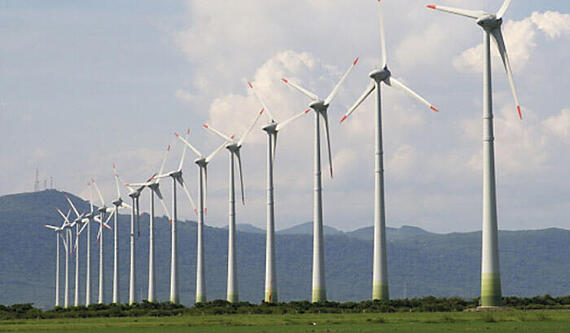
(provided by UNEP; location and time unknown)
The report, entitled "Emissions Gap Report 2022: The Closing Window - Climate crisis calls for rapid transformation of societies," is about 130 pages long, including the summary and main body of the report. Experts from various countries, divided by sector, analyzed vast amounts of recent data on climate change measures and their effects. As a result of these efforts, the report concludes that the greenhouse gas emission reduction measures currently being taken by countries will result in an increase of 2.8℃ above pre-industrial levels by the end of this century.
Since COP26, held October to November 2021 in Glasgow in the UK, countries have submitted emission reduction targets for 2030 to the United Nations. The report found that even if countries meet these international commitments, emissions will rise by 2.4 to 2.6℃.
"Optimism is unrealistic"
The Paris Agreement is a multilateral international agreement that was adopted at COP21, held in Paris in December 2015. It aims to limit the temperature increase at the end of this century to less than 2℃ above pre-industrial levels, preferably to 1.5℃. According to the Intergovernmental Panel on Climate Change (IPCC) and other reports, if the temperature increase rises from 1.5℃ and hits 2℃, then extreme temperatures will increase in most areas where humans live, causing extensive damage. For this reason, COP26 adopted a document stating that "efforts will be pursued to limit the temperature increase to 1.5℃," effectively making the Paris Agreement's goal a "1.5℃ target."
The UNEP report calculated greenhouse gas emissions in 2030 with the measures that countries are currently implementing. It estimated that to limit the rise in temperature to 2℃, emissions would have to be reduced by 30%, and to achieve 1.5℃, emissions would have to be reduced by 45%.
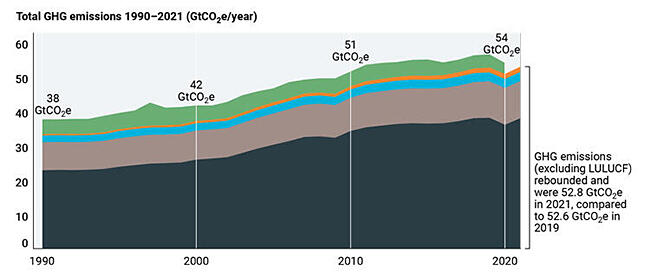
(provided by UNEP)

Right: Trends in greenhouse gas emissions from 1990 to 2020
(provided by UNEP)
Japan has set a goal of reducing its emissions in FY2030 by 46% from the FY2013 levels and of achieving virtually zero emissions by FY2050. The G20, which includes Japan, is a group of 20 countries and regions that accounts for about 75% of global emissions, and, with the G20 in mind, the report stated that "progress since COP 26 is highly inadequate," clearly stating that, "G20 members that have submitted stronger NDC targets since 2020 have just started the implementation of policies and actions. Unless measures are dramatically strengthened, emissions will be reduced by less than 1% of projected global emissions in 30 years."
The report also states that temperature rise will be limited to 1.8℃ if countries can achieve their 2030 emission reduction targets and achieve virtually zero emissions by 2050, but declares that such optimism is "unrealistic" given the reality of current efforts by individual countries.
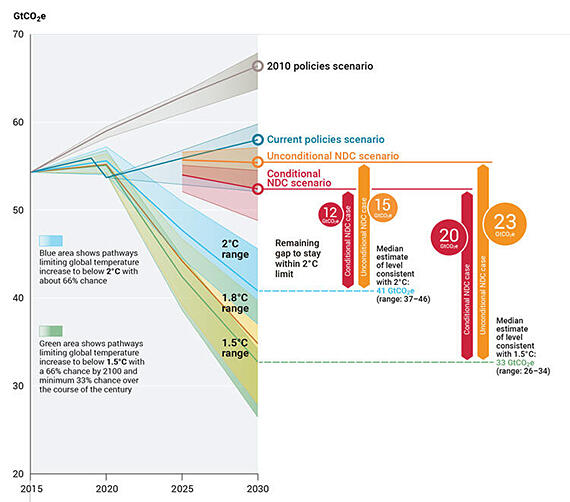
(provided by UNEP)
"Rapid transformation of societies only option"
The headline of the press release for the report reads that, "Inadequate progress on climate action makes rapid transformation of societies only option." The report also describes in detail the social changes that will be required for the future.
The report noted that food-related emissions, from production to consumption, account for one-third of total emissions. It estimated that food-related emissions in 2050 could be reduced to one-third of current levels if bold measures were taken to improve food production methods, decarbonize food supply chains, and change consumer behavior by reducing meat consumption as much as possible.
In addition, the report called for an end to investment in fossil fuels and thorough decarbonization in the industrial, electricity supply, transportation, and building sectors. It also noted that transforming to a decarbonized economy would require at least US$4-6 trillion per year in investment and the need to transform the financial system toward decarbonization.
The UNEP's report also draws on scientific findings and other information incorporated in the IPCC's voluminous Sixth Assessment cycle reports. Many of the numerical projections are based on analysis by supercomputers. While these are highly reliable and persuasive, none of the listed measures are easy to implement. Realizing the listed measures through ordinary efforts is expected to be impossible. The report suggests, in effect, that the climate crisis is inevitable in the future, and that we are now at the "adaptation" stage, that is, how human society can overcome this crisis.
The design of the report's cover is also unusual, reflecting the harshness of the report's content. In the center of a dark wall that looks like black and brown smoke and haze, there is a white-framed window that is about to close, and, on the other side of the window, there is a small view of a blue sky, green hills, and colorful flowers. Many of the rungs on the ladder under the window are also either broken or missing, indicating that it will not be easy to open the window wide. It conveys a strong sense of crisis.
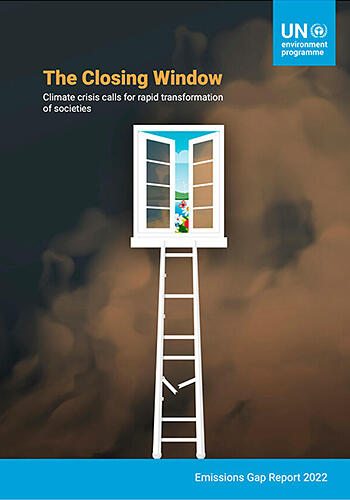
(provided by UNEP)
COP27 ― results cannot be predicted in the face of the "climate crisis"
UNEP Executive Director Anderson commented on the report as follows: "We had our chance to make incremental changes, but that time is over. Only a root-and-branch transformation of our economies and societies can save us from accelerating climate disaster," and that "It is a tall, and some would say impossible, order to reform the global economy and almost halve greenhouse gas emissions by 2030, but we must try." "We have to start the social transformation now." "We can firmly open the window on the 'end of climate action' and begin changing the world for the better."
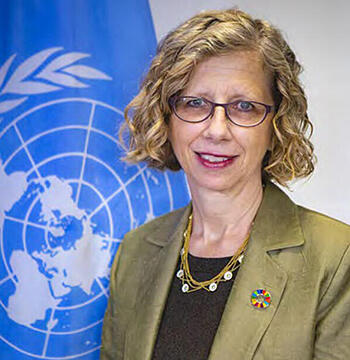
(provided by UNEP)
The warning issued by UN Secretary-General António Guterres in conjunction with the release of the report is even more blunt. "Unless countries dramatically scale up their efforts to counter the climate crisis, the world faces a global catastrophe."
COP27 was held in Sharm El Sheikh, Egypt, from November 6 to 18. Can the 2030 greenhouse gas reduction targets (also known as Nationally Determined Contributions or NDCs) be significantly increased? How should "adaptation measures" to climate change be implemented? Can developed countries agree on "adaptation finance" for developing countries? There are many difficult issues on the agenda. Even in the face of the "climate crisis," real interests among countries have already been at odds in some of the preliminary discussions, and it remains to be seen whether any concrete results will be achieved.
(UCHIJO Yoshitaka: Science Journalist)
Original article was provided by the Science Portal and has been translated by Science Japan.




